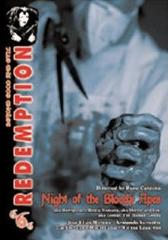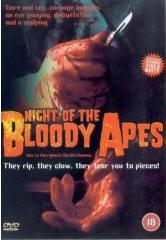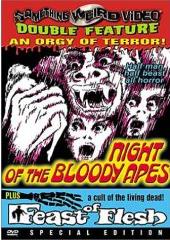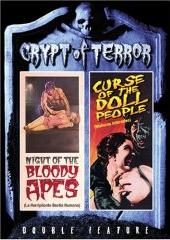|
Find interviews by: | ||
Night of the Bloody Apes Director: Rene Cardona
But there’s more to Night of the Bloody Apes than wrestling babes, because this my friends is an honest-to-goodness video nasty - one of the list of banned titles compiled by the Director of Public Prosecutions in 1984. Nowadays of course most of the films on that list can be bought for £4.99 down Tesco but nevertheless there is still a certain cachet to them. The video nasties were an eclectic bunch of films and ranged from the truly nauseatingly sick to the hilariously inoffensive. This is certainly one of the sillier films on the list and it sports a plot which is best summed up as typically barking for Mexican popular cinema. A certain Dr Krallman (Jose Elias Moreno, who played the title role in the notorious 1959 Mexican movie Santa Claus) is the physician called in to examine Elena Gomez. He has a grown-up son, Julio (variously pronounced ‘HOO-leo’ and ‘JOO-leo’ on the dubbed soundtrack) who is very ill with leukemia (pronounced, at one point, ‘loo-SEE-mia’); Julio is played by Agustin Martinez Solares who was also in Santo and Blue Demon vs Dracula and the Wolf Man. After Lucy and Elena’s wrestling bout we have another trademark of Mexican cinema (in fact, of all cheap-and-cheerful populist film-making) with a staggeringly bad day-for-night scene. As the sun beats down from the heavens, Dr Krallman and his scar-faced assistant Goyo (Carlos Lopez Moctezuma: Curse of the Crying Woman, El Hombre y la Bestia) turn off the headlights on their car and break into the local zoo. After some shots of an orang-utan, overlaid with the sort of scary growls that orang-utans don’t make, we see Krallman put together a rifle and shoot a painfully obvious man-in-a-suit gorilla, which the two men then remove from its cage and take home.
But we all know what happens when you put a gorilla heart inside a human, don’t we, boys and girls? In possibly the most unconvincing lap dissolve in cinematic history, Julio transforms into (as the original title has it) La Horripilante Bestia Humana - and I think we can all translate that, even if we don’t speak Spanish. The bestia in question is as muscular as a body builder and has an ugly grey, Neanderthal face with a crop of shaggy black hair. Except in occasional extreme close-ups of its eyes, when its skin turns pale brown and all the hair disappears. It’s the most mismatched pair of images since Night of the Demon. Naturally the beast escapes through a window and goes on a rampage and this is where I think the DPP may have been shocked as there is a violent - but frankly nonsensical - rape scene. A young woman having a shower (Gina Morett) is disturbed by the beast but has time to wrap a towel around herself. He carries her, topless but with the towel strategically placed, to her bed where he proceeds to rape her - without removing either the towel or his trousers. Legend has it that a more extreme version of this film, using alternative takes of the horror and sex, was released under the does-what-it-says-on-the-tin title Horror y Sexo. But in this version, there’s not much horror and the sexo is relatively tame. The other odd thing about this rape scene, apart from the two (possibly three) layers of cloth between the participants’ genitals, is the amount of blood that is splattered over the victim and up the wall, despite the lack of any obvious injury.
Unfortunately the human heart only restores Julio’s humanity temporarily and before you can say “Madre de Dios!” he has reverted to his horripilante self like a sort of low-rent Latin American Jekyll and Hyde. He leaps out of the rather hamfistedly repaired window and sets off an another rampage, this time attacking a young couple in a park. He rips the man’s head from his neck and sets about raping the woman, who wears a green 1950s-style dress and has red hair piled high in a beehive, making her look rather like the loud one out of the B-52s. There are two great aspects to this sequence. One is that, when the woman extricates herself from the monster and runs away her hair is frizzed and her dress torn to shreds, but when she runs into a nearby shop pleading for help her dress is once more intact, her hair is piled up high and she looks ready to launch once more into the backing vocals on ‘Shiny Happy People.’ The other amusing thing is the painfully obvious interior nature of the studio set claiming to be a ‘park’, which is hammered home not only by the astroturf on which the attack takes place but most especially by the way that the energetic monstrous rape causes the astroturf to bunch up, revealing the studio floor beneath it. It’s a real Ed Wood moment. Police Lieutenant Arturo Martinez (remember him?) is investigating all this and it all ends up... oh, I don’t know. Who cares? Night of the Bloody Apes isn’t a film you watch to find out what happens in the end, it’s a film you watch to marvel at the insane stuff that happens along the way (which includes another two wrestling bouts). Writer/director Rene Cardona churned out more than 200 films from the 1920s to the 1980s including at least nine Santo movies plus such legendary mexploitation pictures as The Brainiac, Tom Thumb, Santa Claus and Wrestling Women vs the Aztec Mummy. He started out as an actor with roles in Mexican versions of The Count of Monte Cristo and Lady Windermere’s Fan. Cardona co-wrote this picture with his son, Rene Cardona Jr (the cause of much confusion for filmographers as he also directed about a hundred films including Night of a Thousand Cats and Tintorera - Tiger Shark). Some additional footage for this English language version was shot in the USA by Jerald Intrator (Satan in High Heels). Composer Antonio Diaz Conde also scored The Aztec Mummy vs the Human Robot and a 1958 Mexican version of The Invisible Man. Cinematographer Raul Martinez Solares handled the camera on scores of wrestling movies and (allegedly) some episodes of the 1960s Tarzan TV series starring Ron Ely.
In 1993 the notorious Vipco label planned a release but there is no record of a BBFC certificate. Some uncut review copies of this made it into circulation but the planned release was presumably a version still further cut. Six years later a 77-minute version (probably the intended Vipco edit) was released by Sovereign Multimedia on their Satanica label. This was given an 18 certificate by the BBFC and I remember reviewing it for SFX at the time. For some reason, the film was submitted again in 2002, in the same 77-minute version, by Film 2000 - and was again given an 18, naturally. Redemption’s version runs 84 minutes, making it even longer than the original theatrical release although as I type this, about five weeks before the DVD comes out, there is no sign of this version on the BBFC website. But to be frank I can’t see what anyone could possibly object to. What little gore is on show here is hamfistedly edited - to the extent that it still looks cut - and is nothing more than a few brief shots of throats being ripped etc. There is that first rape scene but it’s not salacious or exploitative, just silly. And I can’t imagine there would be a problem with the heart transplant footage. The Redemption presentation is full-frame, scratchy at reel ends and the colours are a bit intense (especially Lucy’s red costume) but to be honest, who wants a pristine version of a movie like this? The extras are... well, haphazard is the adjective that springs to mind. There are two trailers: one for Jean Rollin’s Requiem for a Vampire (with English captions but no narration or dialogue) and one for Rollin’s Les Demoniaques (with French captions but no narration or dialogue). Both of these are random collections of images which tell you nothing about the films (except that they feature nude woman and clowns) but a lot about how people cobbled together international trailers in the early 1970s. There is no trailer for Night of the Bloody Apes. The stills gallery is simply five photos; they are shots from the film and are presented here in a small frame, taking up about a quarter of the screen - so what’s the point? You could just freeze-frame the DVD at those moments and see the same images four times as large. The ‘promo art’ has three images: the original 1983 British video sleeve; the Something Weird US video sleeve (which double-billed the film with Feast of Flesh) and an unidentified original poster which calls the film Korang - La Terrificante Bestia Umana and is more interesting than all the other extras put together. The sleeve blurb has two typos and the only quote they could find is from the plot summary on the IMDB! Never mind the video nasty tag, Night of the Bloody Apes is bonkers mexploitation of the highest order and for that reason is essential viewing. MJS rating: B+ DVD: Amazon.com | ||

 You know you’re watching a Mexican movie when the first five minutes consists of two people in coloured costumes and masks hurling each other around a wrestling ring. In this case the
You know you’re watching a Mexican movie when the first five minutes consists of two people in coloured costumes and masks hurling each other around a wrestling ring. In this case the  Krallman’s plan - you may want to write this down - involves transfusing the gorilla’s blood into his son ... but, because a human heart would not be strong enough to pump gorilla blood, he has to transplant the heart too. This he does, using stock footage of a genuine human heart transplant. Rather wonderfully, the surgical close-ups show two pairs of hands at work, intercut with shots of another pair of hands holding the anaesthetic mask to Julio’s face. But long shots confirm that only Krallman and Goyo are involved - so whose are the other hands? I also love the way that Krallman tells his son he won’t leave his side for a moment then promptly leaves the room with Goyo to stick the ape carcass in a convenient incinerator.
Krallman’s plan - you may want to write this down - involves transfusing the gorilla’s blood into his son ... but, because a human heart would not be strong enough to pump gorilla blood, he has to transplant the heart too. This he does, using stock footage of a genuine human heart transplant. Rather wonderfully, the surgical close-ups show two pairs of hands at work, intercut with shots of another pair of hands holding the anaesthetic mask to Julio’s face. But long shots confirm that only Krallman and Goyo are involved - so whose are the other hands? I also love the way that Krallman tells his son he won’t leave his side for a moment then promptly leaves the room with Goyo to stick the ape carcass in a convenient incinerator. Recovering his errant boy, Krallman decides to put a human heart back in, but as the donor must be alive, he uses Elena, the
Recovering his errant boy, Krallman decides to put a human heart back in, but as the donor must be alive, he uses Elena, the  The history of
The history of